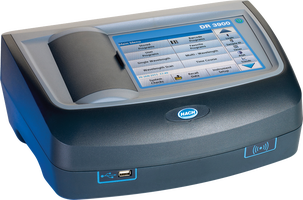-
English (US)
Choose your country or region:
Europe
Asia - Australasia
Middle East - Africa

Chloramination disinfects drinking water by adding chlorine and ammonia to achieve a residual of monochloramine. Chloramination is favored for disinfection when there is a need to reduce the risk of disinfection byproducts (DBPs) formation and to extend the useful life of residual in the distribution system.
Understanding of the breakpoint chlorination curve will help you control the process and minimize the formation of undesirable chloramines, like dichloramine and nitrogen trichloride.
Watch the video to understand chloramination and the breakpoint chlorination curve.

Chloramination sometimes replaces chlorination to accomplish more reliable disinfection, because it can reduce the likelihood of formation of certain disinfection byproducts (DBPs) and provides a longer-lasting residual in distribution systems. Chlorination typically refers to application of chlorine to achieve a residual of free chlorine. Chloramination refers to purposeful reaction of chlorine with ammonia to create residual concentration of monochloramine, NH2Cl.
See which of our spectrophotometers is best for your specific application and methods.


Chloramines have lower reactivity compared with free chlorine and they react less intensely with various impurities in raw water, particularly organic substances. This results in the formation of fewer carcinogenic DBPs, primarily trihalomethanes (THMs). This is one of the most important factors contributing to the demand for replacing chlorination with chloramination. Also, because of reduced oxidizing power, chloramines create a substantially smaller disinfectant demand, which significantly reduces chlorine consumption to maintain a desired total chlorine residual in the water, which lowers the treatment cost.

Proper control of the chloramination process is critical to successful formation and maintenance of monochloramine while minimizing or eliminating the possible formation of undesirable chloramines (dichloramine and nitrogen trichloride) and chance of nitrification.
With analytical testing, you can:
Learn how the City of Corpus Christi used the SL1000 PPA to battle nitrification issues.
Learn how to use the Hach SL1000 Portable Parallel Analyzer for fast, accurate and easy field testing.
The 5500sc Ammonia Monochloramine Analyzer provides all the information you need to prevent nitrification.

Chloramination is a multifaceted process that involves a variety of factors and every facility and operation is different. Whatever your needs, Hach® is ready to help with information, technology and support.
While chloramination provides some benefits over chlorination regarding the formation of fewer disinfection byproducts (DBPs) – particularly trihalomethanes (THM) that exhibit carcinogenic properties – it requires thorough monitoring to maintain control and ensure optimal results. Successful chloramination is based upon monochloramine formation from free chlorine and ammonium and this process requires strict control to prevent unintended consequences such as nitrification in the water network. In order to achieve the necessary control and better optimization of water treatment processes, operators must carefully monitor formation of monochloramine as the target disinfectant.
Explore the different types of chlorination parameters and methods below.
Test for total chlorine to determine total disinfectant residual levels in produced potable water. The total chlorine concentration is required by most regulatory agencies for compliance reporting purposes. Use the total chlorine concentration for calculating the CT credits and optimizing the treatment process. Select the DPD Total Chlorine method that adequately covers the expected chlorine concentration and gives the test sensitivity and concentration resolution desired. The method required may change depending upon the sampling point within the treatment system. The titration methods are easily adapted to meet the test ranges required in the treatment process.
To ensure successful chloramination, it is also important to measure raw materials such as hypochlorite and aqua ammonia, which are unstable and may decrease in concentration during transportation and storage. It is also necessary to measure interferences such as iron and manganese to ensure the success of the disinfection processes.
Contact us for tech support, service, sales, or to get a quote.